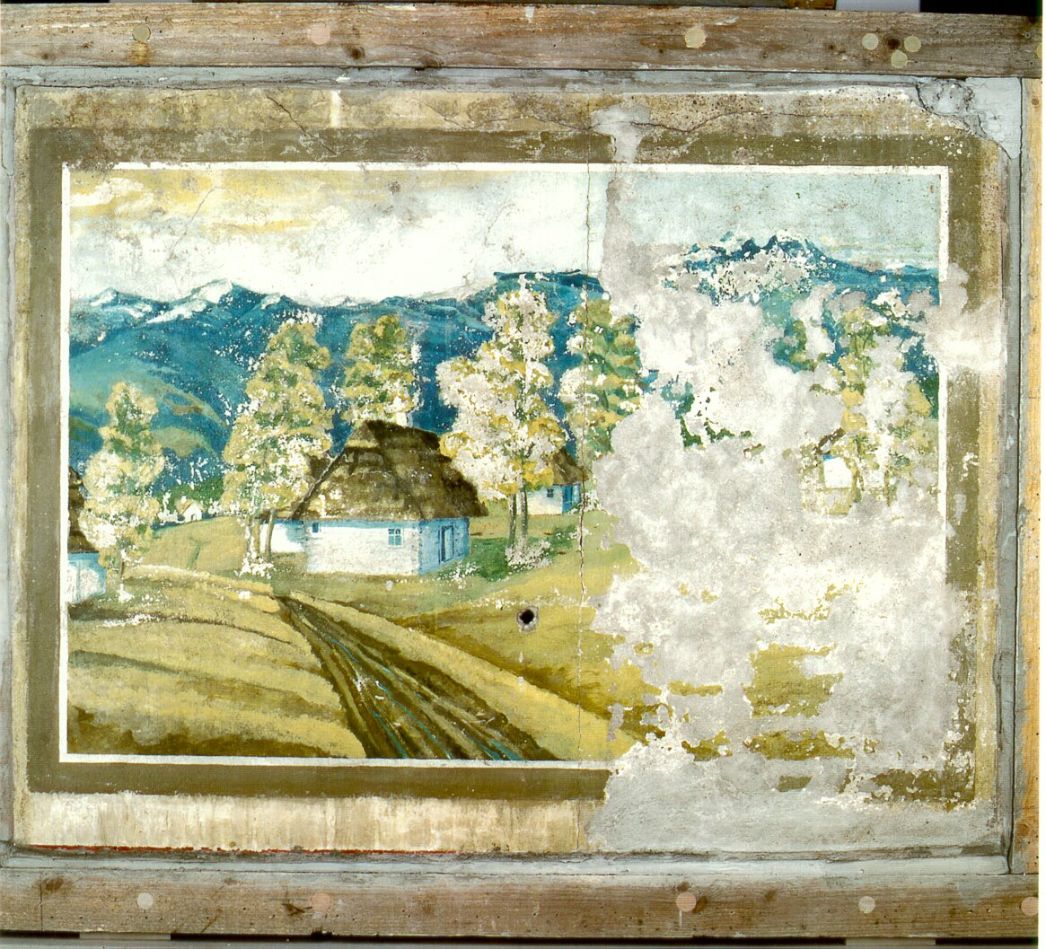
In early 1945, the Polish inmate Józef Szajna painted this Carpathian landscape on the wall of a barrack in Schönebeck, a subcamp of Buchenwald. Some twenty-three years of age at the time, he had already endured one year of forced labour and before that three years in Auschwitz.
The motif was one he was well acquainted with. The Wooded Carpathians, or Bieszczady Mountains spread out less than a hundred kilometres from his native Rzeszów. With their long mountain chains and partly grassy ridges, they were his home. He painted the river valley with a meadow and simple white high-roofed houses amongst trees and tree clusters from memory. Distinguished by their woodless peaks and green slopes, these mountain ranges are a somewhat lonely and deserted region, little developed and known mostly to hikers and skiers. Perhaps the painted landscape is a reminiscence of Józef’s holidays in rural Stobierna with relatives of his mother, who had died in 1937, and of the temporary refuge he and his older brother Aleksander had found there in 1939/40 in the attempt to flee from the German occupiers. Yet the image of the mountainous region in the springtime may also have meant something to the painter above and beyond his personal memories: the landscape was considered Polish heartland and associated with the national consciousness. Owing to the painful experience of war and the occupation of 1939/45, it thus held special meaning for Polish prisoners.
Szajna painted this scene on the barrack wall in 1945 with the nitro paint used to lacquer aircraft parts. It was a phase when the Allies were bombing the armaments works in Schönebeck and hopes of the war’s end were growing. A second image has also come down to us—a flower still life, likewise on exhibit in the art museum. It is not known whether the paintings bore a relation to commissions Szajna had received from a member of the SS who gave him several bowls of soup by way of payment, as he later recalled. Marked by the traces of the half-century since the end of the war, the two wall paintings were discovered by memorial historians in 1992 and installed by conservators in the Buchenwald Memorial Art Museum in 1997.
Biography
Józef Szajna was born in Rzeszów in the heart of the Carpathian foothills in south-eastern Poland on 13 March 1922. After the German invasion of Poland he joined the Polish resistance movement. He fled his native country and was captured in Slovakia in 1941, turned over to the Gestapo in southern Poland, and deported to Auschwitz on 25 July 1941. In November 1942, after an operation to smuggle letters on a laundry cart was discovered, he was assigned to the camp delinquent company. He contracted typhus and became severely ill. In the infirmary, inmate assistants saved his life by obtaining additional rations for him and protecting him from selection by the SS doctors. In August 1943, he attempted escape but was caught. The newly appointed camp commander pardoned him, however, after he had spent two weeks in a standing cell and six weeks in a mass cell awaiting his execution.
On 21 January 1944, Szajna was transferred to the Buchenwald concentration camp and sent on from there to the Schönebeck subcamp to perform forced labour in the Junkers aircraft and engine factory. On 11 April 1945 he managed to flee from a death march.
After the war, Szajna studied at the Academy of Fine Arts in Krákow from 1947 to 1953. He earned diplomas in the fields of graphics (1952) and stage design (1953) and taught at the same academy from 1954 to 1965. From 1955 to 1963 he worked as a stage designer, author, and stage director at the Teatr Ludowy (People’s Theatre) in Nova Huta, between 1963 and 1966 as artistic director. In 1971 he was appointed director of the Teatr Klasyczny (Classical Theatre) in Warsaw which under his aegis was reorganized as the Teatr STUDIO (Studio Theatre) with a gallery, and later the Centrum Sztuki STUDIO (Studio Art Centre). In 1972 he became a professor at the art academy in Warsaw. In 1982 he reacted to the declaration of martial law in Poland by resigning from his professorship and stepping down as director of the Centrum Sztuki STUDIO.
Szajna attained worldwide fame with numerous exhibitions and theatre productions as well as his participation in the Venice and Sao Paulo biennales. He received an honorary doctorate from the University of Oldenburg in 2002. Józef Szajna died in Warsaw on 24 June 2008.


